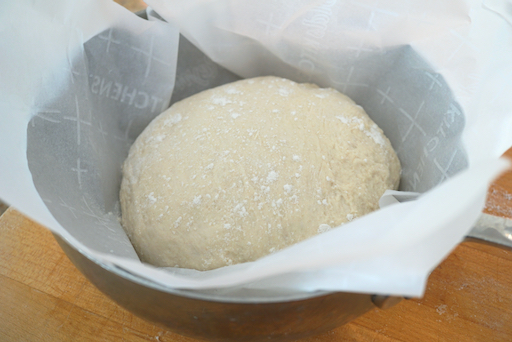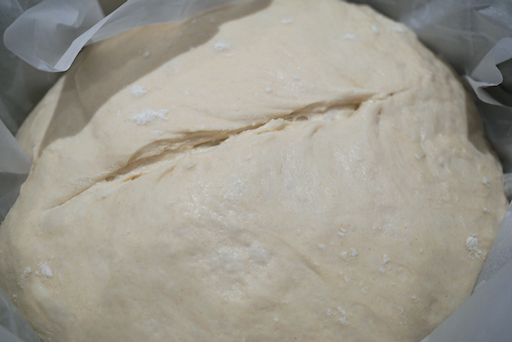Ingredients: (I am listing the original Kenji's recipe and metric weight in parenthesis which I converted by weighing the ingredients but not just numerical conversion of "cups" and "tsp", "tbs").
3 cup (425g) AP flour (Instead of bread flour, this recipe uses AP flour, I am not sure why but I should try it with bread flour).
3/4 cup plus 2 tbs (207g) water
6 tbs (80g) beer*
1 tbs (13g) white distilled vinegar (I used rice vinegar)
(Total liquid of 290g which makes hydration rate of 68%)
1 1/2 tsp salt
1/4 tsp instant yeast
*Kenji recommends to use light Pilsner-style lager beer such as Budweiser. I did not have Bud in our fridge so I used Sam Adams' Boston lager.<
Directions:
In a bowl, mix the ingredients using a wood spoon until no dry flour remains.
Cover the bowl with plastic wrap and let it rise for 8-12 hours in a warm place (I used our proofing box at 85F for 8 hours).
Take the dough out and put on a floured board and knead 10-15 times. Make into a boule-shaped dough ball.
Place the dough in a parchment paper lined skillet (below picture. Kenji's recipe include spraying with vegetable spray but I do not see the need for that and skipped that process).
Place this uncovered in the proofing box (the box has a water tray providing moisture to prevent a skin from forming on the dough). Let it rise for the second time for 1-2 hours.
Take the dough out and put on a floured board and knead 10-15 times. Make into a boule-shaped dough ball.
Place the dough in a parchment paper lined skillet (below picture. Kenji's recipe include spraying with vegetable spray but I do not see the need for that and skipped that process).
Place this uncovered in the proofing box (the box has a water tray providing moisture to prevent a skin from forming on the dough). Let it rise for the second time for 1-2 hours.
Meanwhile, put the cast iron pot in the oven and preheat the oven to 450F at least 30 minutes before the second rise is done.
Using a lame, slash the top of the dough (see below).
Transfer the dough to the hot cast iron pot using the parchment paper.
Bake for 30 minutes with the lid on and 5-10 minutes more minutes with lid off.
Bake for 30 minutes with the lid on and 5-10 minutes more minutes with lid off.
As you can see in the picture below the resulting loaf was picturesque. It actually came out exactly like the picture in the book (on the front cover of the book).
Let it cool down completely (at least several hours or more) on a cooling rack before slicing.
When I mixed the dough, I thought this is too dry and would not work. But after 8 hours of rising, the dough was quite wet but it could be handled and kneaded. Using the parchment paper made transferring the dough to the hot cast iron pan much easier and safer. It also didn’t result in somewhat deflating the dough as happened with other method. Since the dough can be formed and slashed, it came out exactly like in the picture.
We lightly toasted a slice, lavishly buttered it and tasted. The crust was crunchy and the interior moist. The flavor was wonderful. The vinegar and beer emulated the sour dough taste complex and added real depth of flavor. This is definitely the best bread of this kind I ever made.






No comments:
Post a Comment